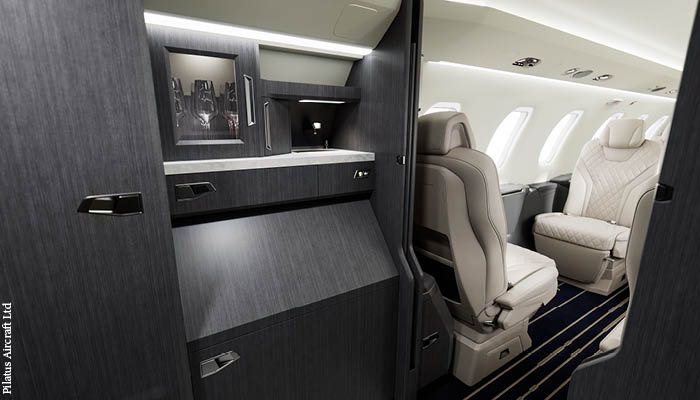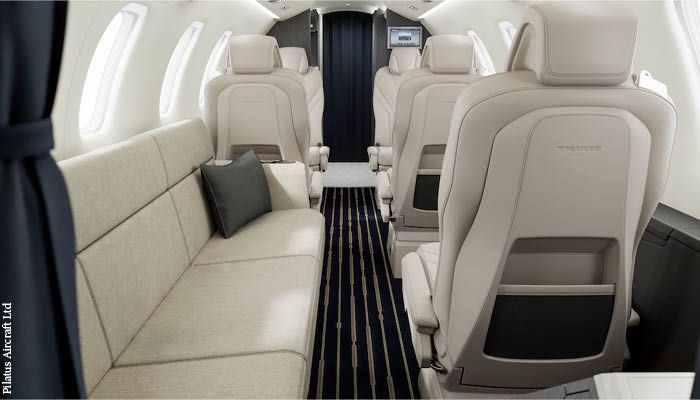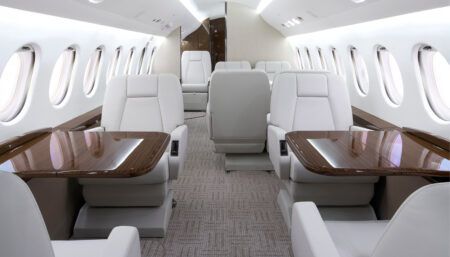Updates to the Pilatus PC-24 ‘Super Versatile Jet’ include a new divan, compact but powerful IFE, bio-based material options and more, writes Guy Bird
Listening to your customers is usually a wise business move, one that Swiss aircraft maker Pilatus has clearly adopted in updating the PC-24 ‘Super Versatile Jet’. The updates begin with extended payload-range for new aircraft deliveries from 2024. This was a direct response to customer feedback.
“We decided to look deeply into the aircraft’s structure and see where we could take out weight,” explains Flavia Vianna, director of product management, business aviation, Pilatus. “We modified a lot of the structural parts during this rework. We really went to the extreme and even reviewed some manufacturing processes. It was a long process that included a flight test campaign to guarantee no changes to the handling of the aircraft.”
Trimming the weight
Pilatus refined wing and fuselage structural elements – including making some ground spoilers out of carbon fibre – and lots of these little changes result in the revised PC-24 benefitting from a 600 lb (272kg) increase in full fuel payload, to 1,314 lb (596kg). Maximum payload capacity is 3,100 lb (1,406kg). This enables operators to increase the aircraft’s maximum range by 200 nautical miles (370km) to 2,000 nautical miles (3,704km) with six passengers. These changes enable operators to enjoy one of the aircraft’s key selling points even more – its large cargo door and inflight-accessible cargo area.

Spatial awareness
Vianna says that while most of the interior feedback was already great, it’s part of her job to dig in to optimise the cabin ever further. The aircraft got a forward galley option in 2019, which has a ‘pick-rate’ exceeding 80%. Customer feedback revealed the forward area could be improved, specifically regarding the sink’s envelope. “It’s an iconic piece that I can say was designed with heart and soul, but it wasn’t optimal for the space,” says Vianna. “When cabin crew served a coffee they had to put the jug somewhere else, so we now have a bigger and nicer countertop area. We have made better use of the space.”
She continues that the entrance area encapsulates the aircraft’s modular design: “We have a crystal cabinet option, but if it’s not something you want, it can be pulled out. All these details make the cabin adjustable to specific customer needs.”
The PC-24 design has always prioritised flexibility, enabling seats to be removed quickly for example. “This is unique to our interior, and it saves carbon footprint by reducing weight and therefore fuel consumption,” says Vianna. “You can take parts out that are not needed for that specific mission.”
Divide and conquer
A similar analysis was applied to storage spaces. “We had lots of big cabinets that weren’t optimised for every usage, because they didn’t have enough partitions and just seemed big and empty,” says Vianna. “However, some customers use the big space for blankets or pillows and we didn’t want to lose that functionality either. The solution was to redesign the cabinets in a way that they could be filled up with modular containers and dividers. These can be removed if you’re not going to use them. Moreover, even the cabinets can be pulled out too if not required.”
The pilot can take the cabinets out, recalculate weight and balance “and you’re off to fly without that weight if you’re not going to use it,” says Vianna.
Sleeping beauty
A crucial change is the new side-facing divan option. The divan is 6ft 6in (1.98m) long and can be converted into a bed in flight. Vianna says that even though typical flights for this airframe are two to four hours long, people still want to be able to sleep. Since the PC-24’s original launch, the seats have been reworked and recertified to add full recline, but Pilatus still wanted to offer “a proper bed”, in the aft, quieter area of the aircraft, and make it as big as possible.
“It’s a huge divan,” says Vianna. “At NBAA-BACE we couldn’t find anybody that couldn’t lay head-to-toe on it. To optimise comfort even further, you can pull it open and it becomes a comfortably sized bed. We also added everything you can think of: there are drawers underneath; plug-in tables for eating on; power outlets and USB ports; and cupholders everywhere. We used to have a requirement for one cupholder per passenger, so we doubled that just to make sure. On the divan I actually added two more cupholders just because we had space at the back of the sideledge.”

Single-box IFE
An upgrade to the IFE/CMS is a key change. Lufthansa Technik created an Ethernet-based, customised version of its ‘nice’ system, housing the entire system in a single, compact line-replaceable unit. “That saves weight with no compromise on what we offer the customer,” says Vianna. “Everything you would expect in a bigger aircraft, you have here, and for very little weight.”
The ‘integrated CMS 4.0’ (iCMS 4.0) system features a 10in touchscreen controller (positioned on a bulkhead); 3D moving map; USB ports; 1TB of storage space for personal AVOD; and four high-fidelity cabin speakers with optional subwoofer, HDMI input and mood lighting. The wi-fi is capable of simultaneous 2.4GHz and 5GHz, and there is a Bluetooth transceiver for audio sink or source; and multicast streaming.
Jigsaw puzzle
“Lufthansa Technik went the extra mile to meet our weight and envelope targets, because we’re focusing on releasing space for customer use,” explains Vianna. “We wrote a very tight requirement list, by listening to our customers on what’s necessary and expected on the PC-24.”
Fitting in the box was still quite a task. “Most aircraft in this category have a drop-down aisle, and they use that space under the seats for the electronics,” says Vianna. “We don’t want to do that to our nice flat floor, which is very comfortable, so we had to find some space between frames.”
Customers don’t have too long to wait to enjoy these changes. The divan and IFE system are still prototypes, displayed at NBAA-BACE 2023 on an aircraft with an experimental certificate, to gain feedback. The targeted entry into service is Q2 2024 for the divan and Q3 2024 for the IFE. All the other updates will feature on new aircraft delivered from 2024.
This feature was written by Guy Bird and first published in the December 2023/January 2024 edition of Business Jet Interiors International. Read the full version here.
F/List created a customised version of its F/Lab Aenigma bio-based material for the bulkheads and decorative surfaces of the PC-24 shown at NBAA-BACE 2023. Click here to learn more.





